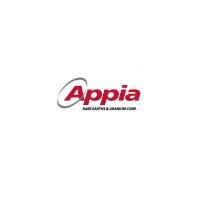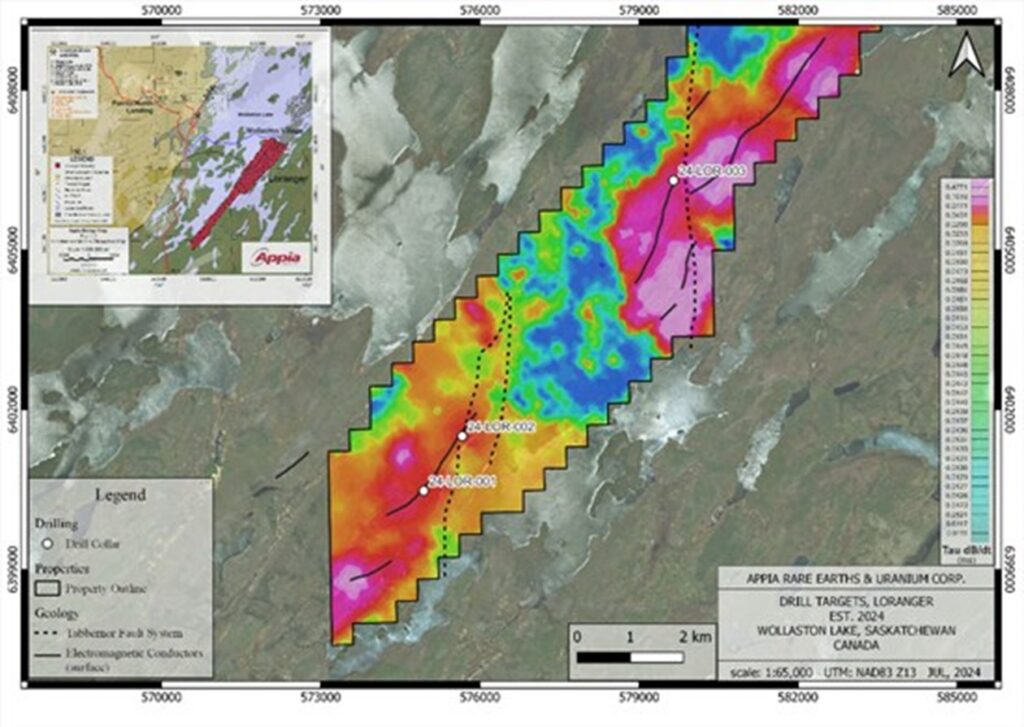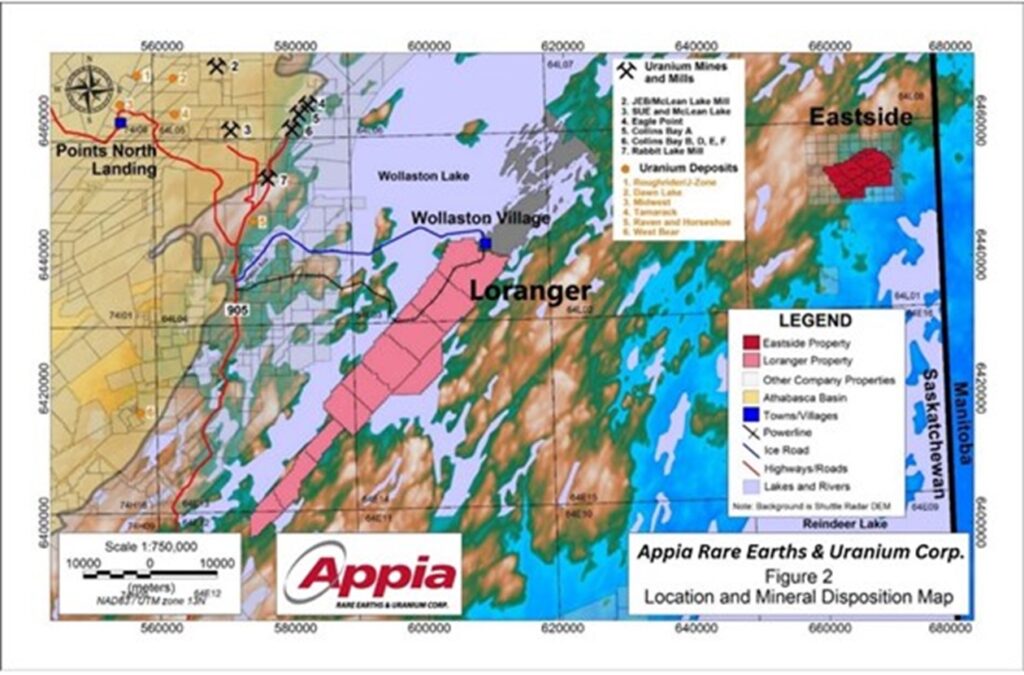
Appia Confirms Discovery of Uranium and Rare Earth Element Mineralization in Exploratory Drill Holes at the Loranger Project, Saskatchewan, Canada

Appia Rare Earths & Uranium Corp. (CSE: API) (OTCQX: APAAF) (FWB: A0I0) (MUN: A0I0) (BER: A0I0) is pleased to announce the confirmation of intersecting uranium and rare earth elements mineralization while drill testing the potential of three exploratory targets at the southern limits of Appia’s Loranger property located south of Wollaston Lake, Saskatchewan. The drill results, analyzed and verified by the Saskatchewan Research Council Laboratories in Saskatoon, confirm the Company’s early-stage geological hypotheses to locate a set of subsurface, variable length (2.2 to 2.5 km) electromagnetic conductors (Figure 1) favorable for U and REE mineralization. The success of this drilling program highlights the potential of the Loranger property as a dual-commodity property within Appia’s portfolio.
Highlights of the 2024 Assay Results:
- Uranium Mineralization:
- Drill Core 24-LOR-003: 0.10 m of 409.11 ppm (0.04 wt%) U3O8 from 171.31 m to 171.41 m, confirming the presence of uranium alongside rare earth elements within the same 2.2 km electromagnetic conductor / Tabbernor Fault intersection.
- Rare Earth Element (REE) Mineralization:
- Drill Core 24-LOR-003: 0.18 m of 0.56 wt.% TREO from 154.02 m to 154.10 m, including a 0.10 m interval of 0.80 wt.% TREO, confirming the presence of rare earth elements between the northeast trending 2.2 km EM conductor and N-S trending Tabbernor Fault (Figure 1).
- Drill Core 24-LOR-003: 0.10 m of 0.36 wt.% TREO from 171.31 m to 171.41 m.
Additionally, 20 more samples within hole 24-LOR-003 returned REE values greater than 0.10 wt.% TREO, signifying sporadic rare earth element mineralization within this area. Full assay results click here.
Stephen Burega, President of Appia, stated, “We are excited to announce the confirmed discovery of uranium and rare earth elements mineralization in our first exploratory drill holes within the southwestern block of the Loranger property. These results not only confirm our geologic hypotheses but also highlight the potential for further discovery along the set of variable length (2.2 to 2.5 km) EM conductors, giving our team new drill targets for future programs.”
Importance of Loranger’s Location for Uranium and REE Mineralization:
The Loranger property’s location is strategically significant due to its proximity to the prolific uranium-bearing Athabasca Basin (Figure 2). The Athabasca Basin is renowned for its uranium deposits and nearby rare earth element discoveries, positioning itself as a major source of global uranium production. As a result of the Loranger 2024 diamond drilling program, Appia has confirmed both commodities are present on this property, validating the potential for further discoveries within the Company’s early-stage geological model.
Next Steps:
Encouraged by the positive results, Appia plans to initiate a follow-up program at Loranger to investigate these findings further and expand its work efforts within the proximate area, specifically southwest along strike of the 2.2 km electromagnetic conductor, and within the proximate conjunction between it and the local Tabbernor Fault. This subsequent work will focus on delineating the extent of both uranium and rare earth element mineralization and evaluating the potential for additional discoveries.
Appia remains committed to transparency and will continue to update shareholders and the public as exploration progresses. We look forward to sharing further developments and enhancing our understanding of the Loranger property’s value.
Summary assay tables are presented below. Click here to access the full, detailed geochemical assay results, providing comprehensive information on the highlighted drill hole samples identified during the 2024 Loranger Diamond Drilling Program.

Figure 1 – Drill hole collars, electromagnetic conductors, and Tabbernor Fault System overlaying Electromagnetic Time Constant (dB/dT – EM Tau) Survey.

Figure 2 – Prolific Mines and Exploration Sites – Athabasca Basin, and Peter Lake Domain near Appia’s Eastside Property
Table 1 – Highlighted Drill Hole Composite TREO wt.% and U3O8 wt.% Grades for 24-LOR-003
| Drill Hole ID | From (m) | To (m) | Length (m) | Composite Grade U3O8 (wt.%) | Composite Grade TREO (wt.%) | Including |
| 24-LOR-003 | 154.02 | 154.20 | 0.18 | 0.02 | 0.56 | 0.10. m of 0.80 wt.% TREO |
| 24-LOR-003 | 171.31 | 171.41 | 0.10 | 0.04 | 0.36 | n/a |
Note:
– The REE Thulium (Tm) and Promethium (Pm) are not reported because they are both extremely scarce in nature, and Pm forms as a product of spontaneous fission of U-238.
– TREO = Total Rare Earth Oxides = sum of La2O3 + CeO2 + Pr6O11 + Nd2O3 + Sm2O3 + Eu2O3 + Gd2O3 + Tb4O7 + Dy2O3 + Ho2O3 + Er2O3 + Yb2O3 + Lu2O3 + Y2O3
Table 2 – Drill Collar Coordinates – 2024 Loranger Diamond Drilling Program
| Drill Hole ID | Easting | Northing | Elevation (m) | Azimuth (°) | Dip (°) | EOH (m) |
| 24-LOR-001 | 574947 | 6400472 | 430 | 320 | -55 | 252 |
| 24-LOR-002 | 575667 | 6401504 | 408 | 140 | -60 | 219 |
| 24-LOR-003 | 579625 | 6406313 | 430 | 140 | -70 | 243 |
About the Loranger Project
The Eastside Project is strategically located east of the prolific uranium-bearing Athabasca Basin region of Saskatchewan, Canada. This area is renowned for its significant uranium deposits, surrounding rare earth element plays, and favorable geological conditions that have historically led to high-grade uranium discoveries.
The Loranger Property is situated in close proximity to several known uranium and REE deposits and mineralization trends, notably the Rabbit Lake and Eagle Point deposits. The Loranger project area is 26,409 hectares and is 100% owned by Appia. Based on previous and current geological exploration programs, the project area has been identified as prospective for uranium and rare earth element (REE) mineralization.
* Critical rare earth elements/oxides (CREO) are defined here as those that are in short-supply and high-demand for use in permanent magnets that enable modern electronic applications such as electric vehicles and wind turbines. The “magnet alloy” rare earths (CREO) are neodymium (Nd), praseodymium (Pr), dysprosium (Dy) and terbium (Tb).
Drill core was collected using a helicopter-portable diamond drill and samples were cut into split drill core. The location of the sample selection within drill core was determined using handheld scintillometers and spectrometers. All discovered locations within drill core above approximately 250 counts per second (cps) were sampled. A total of 41 split drill core samples were collected during the 2024 drilling program.
Drill core samples were collected at variable lengths lines apart depending on lithological contacts and measurable radioactivity above Appia’s cutoff of 250 cps. Sample intervals ranged from 0.01 m to 0.25 m in length.
All lithogeochemical assay results of grab and channel samples were provided by Saskatchewan Research Council’s Geoanalytical Laboratory, an ISO/IEC 17025:2005 (CAN-P-4E) certified laboratory in Saskatoon, SK. All analytical results reported herein have passed internal QA/QC review and compilation.
The technical content in this news release was reviewed and approved by Dr. Irvine R. Annesley, P.Geo., Senior Technical Advisor for Appia and a Qualified Person as defined by National Instrument 43-101.
About Appia Rare Earths & Uranium Corp.
Appia is a publicly traded Canadian company in the rare earth element and uranium sectors. The Company holds the right to acquire up to a 70% interest in the PCH Ionic Adsorption Clay Project (See June 9th, 2023 Press Release – Click HERE) which is 40,963.18 ha. in size and located within the Goiás State of Brazil. (See January 11th, 2024 Press Release – Click HERE) The Company is also focusing on delineating high-grade critical rare earth elements and gallium on the Alces Lake property, and exploring for high-grade uranium in the prolific Athabasca Basin on its Otherside, Loranger, North Wollaston, and Eastside properties. The Company holds the surface rights to exploration for 94,982.39 hectares (234,706.59 acres) in Saskatchewan. The Company also has a 100% interest in 13,008 hectares (32,143 acres), with rare earth elements and uranium deposits over five mineralized zones in the Elliot Lake Camp, Ontario.
Appia has 136.3 million common shares outstanding, 145 million shares fully diluted.
MORE or "UNCATEGORIZED"
Kuya Silver Confirms High-Grade Silver-Gold Vein Mineralization at Umm-Hadid with Initial Drill Results up to 1483.9 g/t AgEq over 2 Metres
Kuya Silver Corporation (CSE: KUYA) (OTCQB: KUYAF) (FSE: 6MR1) is... READ MORE
First Phosphate Closes Final Tranche of Oversubscribed Private Placement
First Phosphate Corp. (CSE: PHOS) (OTCQX: FRSPF) (FSE: KD0) is... READ MORE
GFG Receives Final Payment from the Sale of its Rattlesnake Hills Gold Project
GFG Resources Inc. (TSX-V: GFG) (OTCQB: GFGSF) announces that i... READ MORE
Goliath Receives $1,730,882 Through Warrant Exercises, Inclusive Of Crescat Capital A Longtime Strategic And Cornerstone Shareholder
Goliath Resources Limited (TSX-V: GOT) (OTCQB: GOTRF) (FSE: B4IF)... READ MORE
Robex Pours First Gold at Kiniéro on Schedule and Budget
Highlights: Gold bar weighing 2.64 kilograms (85 oz) poured in th... READ MORE












